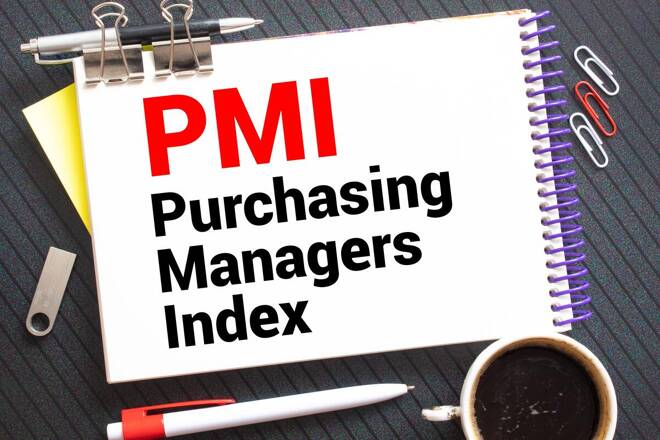Advertisement
Advertisement
Eurozone PMI Hits an 11-Month High but Inflationary Pressures Soften
By:
Euro area private sector PMI numbers drew interest this morning as investors prepare for the ECB monetary policy decision and press conference.
It was a busy morning on the European economic calendar. German trade data drew interest before Eurozone and member states services and composite PMIs.
The German trade surplus widened from €16.0 billion to €16.7 billion in March versus a forecasted €16.1 billion.
While German trade data impressed, the private sector PMIs numbers garnered more interest, with investors looking beyond the headline figures.
The Spanish Services PMI fell from 59.4 to 57.9 in April, while Italy recorded a pickup in service sector activity, with the Services PMI rising from 55.7 to 57.6. Economists forecast PMIs of 59.9 and 56.5, respectively.
However, the finalized numbers from France and Germany were mixed. The French services PMI increased from 53.9 to 54.6, down from a prelim 56.3, with the German Services PMI rising from 53.7 to 56.0, up from a prelim 55.7.
Finalized Euro Area PMIs Come in Softer than Prelim Numbers
For the Euro area, the Services PMI increased from 55.0 to 56.2, down from a prelim 56.6. As a result, the Composite PMI rose from 53.7 to 54.1, down from a prelim 54.4.
According to the Finalized April Composite PMI Survey,
- A pickup in service sector activity supported an April 11-month high Composite PMI.
- In contrast, manufacturing production fell for the first time since January.
- The Spanish economy led the way despite slower growth than in March, with Italy recording a sharp uptick in growth.
- Demand conditions improved, with new order inflows rising for a third consecutive month and at the most marked pace since May 2022.
- However, new export orders fell for the fourteenth successive month, though the rate of decline moderated.
- The rate of job creation accelerated to the strongest since May 2022.
- Rising wages pushed input costs higher, though the inflation rate softened to a 26-month low.
- Output prices also increased at a less marked pace, rising at the weakest pace in two years. However, output price inflation remained elevated.
- Finally, the degree of optimism weakened to a three-month low.
While wage growth will be a concern, the ECB may take comfort in the softer input and output inflation rates. Weak overseas demand will be another concern, however. The numbers suggest an in-line with the forecast 25-basis point interest rate hike this afternoon.
EUR/USD Reaction to Euro Area Composite PMI
Before the private sector PMIs, the EUR/USD fell to an early low of 1.10549 before rising to a pre-stat high of $1.10917. The better-than-expected German trade data delivered a pre-PMI session high.
However, in response to the PMIs, the EUR/USD fell to a session low of $1.10511.
This morning, the EUR/USD was down 0.05% to $1.10550.
Up Next
While the stats drew interest, the ECB monetary policy decision and press conference will be the main event. Economists forecast a 25-basis point interest rate hike. However, the ECB hawks will likely push for a 50-basis point move following the April prelim inflation figures.
A 25-basis point interest rate hike would place the market focus on the ECB press conference.
Looking ahead to the US session, it is a busy day on the US economic calendar. US jobless claims, nonfarm productivity, and unit labor costs will draw interest before Friday’s US Jobs Report.
Hotter-than-expected unit labor costs and a fall in jobless claims would fuel bets on more Fed interest rate hikes.
While investors will consider the stats, the banking sector, the US debt ceiling, and corporate earnings will influence market risk sentiment. Big names on the earnings calendar include Volkswagen, Infineon, BMW, Apple (AAPL), ConocoPhillips (COP), Shopify Inc. (SHOP), and Moderna (MRNA).
About the Author
Bob Masonauthor
With over 28 years of experience in the financial industry, Bob has worked with various global rating agencies and multinational banks. Currently he is covering currencies, commodities, alternative asset classes and global equities, focusing mostly on European and Asian markets.
Advertisement
